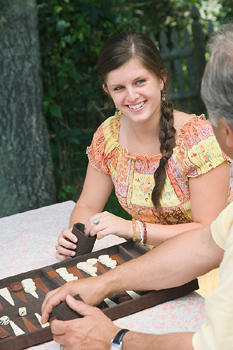How to Play Backgammon
Before we learn how to play backgammon first we’ll begin with its history. Backgammon is often regarded as one of the oldest dice games, known to mankind going back about 5000 years to ancient Egypt. Although the game of backgammon is quite old, it remains quite similar today to when it was first developed. In fact, from the very first version, there are actually only a few minor modifications. While the rules of backgammon can seem quite complicated at first glance, the basic principles of the game are actually very simple to comprehend.
The Backgammon Board
You will need some basic supplies to play but they are typically very easy too obtain, normally coming packaged together with a standard backgammon set.
The most basic pieces are:
- Backgammon Board
- 30 Checkers (15 White and 15 Black)
- Two Dice (6 sided)
- Flat Surface
The board has 24 points on it. These points look like long, narrow triangles alternating between two colors. You are only able to move your checkers on these points and on the bar down the center of the board. The bottom right of the board (closest to you) is called the “home board“ and is numbered one. However, this same board section is also numbered 24 for your opponent. The upper right corner of the board is called “outer board.”
Rules of Backgammon
Backgammon is a two player game although some people play in teams (the rules of backgammon allow for both). The object of the game is to be the first player to move all of your checkers from one side of the board to the other before your opponent does the same. The amount of space that you are allowed to move each piece depends on the numbers appearing on the dice after you have rolled them.
To win the game, you must move all of your checkers to the home board. Once there, they are removed from the board according to the number rolled on the dice. When the checkers are removed from the board, this is called the bear off. When one player bears off all of his or her checkers, they are declared the winner.
Backgammon Setup

How to Play Backgammon
Moving Your Checkers
A player has two choices when it comes time to move their checkers. He or she can either use both dice to move a single checker across the board or they can use one die for one checker and the other die for a different checker. Checkers may only be moved from point to point one at a time. Once the decision has been made and the checkers have been moved, the turn is over. If both dice show the same number, also called a double, you are allowed to play that number four different times with any checker that you choose. When rolling, if only one of the dice numbers is to be played, that player will move the checker according to that number only. If neither die’s number can be played, your turn is done.
During a move, a checker is allowed to land on points that are unoccupied or are occupied by your colored checkers. Also, you can land on a point that has one opposing checker on it. If that happens, put the opponent’s checker on the center line of the board (the bar that divides the two sides). Checkers placed on the bar get back into the game through the opponent’s home-board. All of your checkers on the board are frozen until all of your checkers from the middle have re-entered the game.
Winning Backgammon
Your checkers move towards the home board the entire game. However, when they land on it, they freeze until all of them are in your home-board. Only then may you start removing them from the board, called “bearing off.” You do this by rolling the dice to get that checker off. So, if you have a checker on the 1 point and another on the 2 point, you need to roll a two and a one to bear them off. Also, you must move the lower die before the higher. For example, if you only have one left on the 4 point and you roll a four and a one, you must move the 4 point checker one space to the 3 point and then bear it off using the die roll of 4. It may seem pointless, but a skilled player can use this to their tactical advantage.
It is popular to play backgammon for money or other items. If one player finishes the game before the opponent has born off any of their checkers, it is said the loser has lost a “gammon,” which counts for double a normal loss. If the losing player hasn’t born off any checkers and also still has checkers in the middle or in the winners home board, it is called a “backgammon” and it counts for a triple loss.
